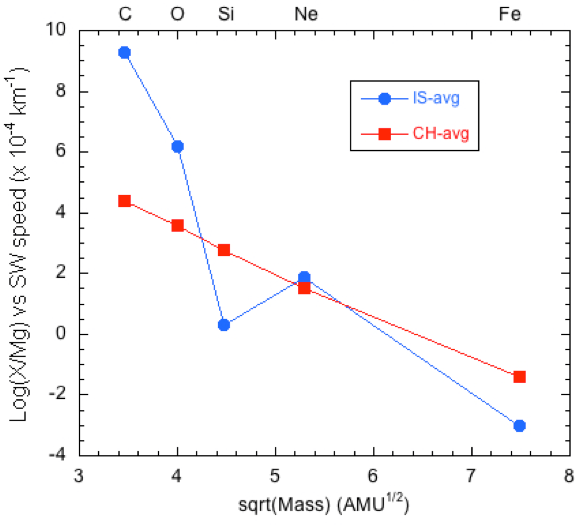First Observation of a Mass-Dependent Effect on the Fractionation of the Solar Wind
Feb 10, 2016
First Observation of a Mass-Dependent Effect on the Fractionation of the Solar Wind
By Daniel Reisenfeld, University of Montana
The sun, like all stars, is composed mostly of hydrogen (90% by mass), a bit of helium (10%), and all the other naturally-occurring elements in the periodic table (<1%). The solar wind is also composed of every element in the periodic table, but the proportions are different. Helium, for example, is less abundant in the solar wind compared to the sun by a factor of two. The change of an element’s abundance between the sun and solar wind is known as fractionation. For some time, it has been known that the fractionation of different elements is not random, but follows an observable trend. Namely, the elements that are easier to ionize have an enhanced abundance in the solar wind compared to those which are more reticent to give up an electron. For instance, neon takes three times more energy to ionize than does iron, and correspondingly, neon has roughly one-third the abundance of iron in the solar wind compared to what is found in the sun. This effect is known as the First Ionization Potential (or FIP) effect, and it has been a topic of study for over three decades.
Another clue to the matter of solar wind fractionation is the observation that the high-speed solar wind generally has abundances closer to solar values (i.e. is less fractionated) than the low-speed solar wind. This has led to the hypothesis that whatever mechanism is responsible for fractionation requires time to act, and it may have less time to operate in coronal hole regions on the sun, where the fast wind originates, as compared to the so-called interstream regions, where the slow wind originates.
Scientists have long searched for other abundance trends that might shed light on solar wind fractionation, in particular any trends which depend on atomic mass. Mass-dependent effects have been observed via telescopic observations of large coronal loops that are depleted of heavy ions, but no mass-dependent effects have ever been observed by instruments directly measuring the solar wind. This is now no longer the case. Using newly re-analyzed data from the SWICS instrument aboard the Advanced Composition Explorer, or ACE, spacecraft, we have taken a careful look at fractionation as a function of solar wind speed. We find that the degree by which fractionation changes with solar wind speed depends on the mass of a given element. In the figure below we plot, as a function of mass, the rate of change in fractionation with speed for a given element. We use the fractionation versus speed for magnesium as the standard to which we compare the other elements. We see that the greater the difference in mass between a given element and magnesium, the greater the difference in fractionation vs. speed (Pilleri et al., ApJ, 812:1, 2015).
Because this is a relative mass analysis, more work needs to be done to determine whether it is the heavy elements or the light elements that show the greater fractionation change with speed. Notwithstanding, seeing such a clear dependence on mass shows that the elemental mass does indeed play a role in the solar wind fractionation process. Understanding this effect should give further insight into the physics of how the elements heavier than hydrogen are fractionated between the Sun and the solar wind. Ultimately, it may address the deeper question of what mechanisms are responsible for accelerating the solar wind in the first place.





